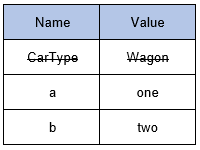Troubleshooting Macro Variable References
When you submit
a macro variable reference, the macro processor resolves the reference
and passes the value directly back to the input stack. You will not
see the value that the compiler receives. To debug your programs,
use the SYMBOLGEN option or the %PUT statement to see what value replaces
your macro variable references. You can use the %SYMDEL statement
to remove macro variables from the global symbol table.
SYMBOLGEN Option Syntax
Use the SYMBOLGEN system
option to monitor the value that is substituted for a macro variable
reference.
|
Syntax, OPTIONS statement
with the SYMBOLGEN option:
OPTIONS NOSYMBOLGEN | SYMBOLGEN ;
NOSYMBOLGEN
specifies that log
messages about macro variable references will not be displayed. This
is the default.
SYMBOLGEN
specifies that log
messages about macro variable references will be displayed.
|
When the SYMBOLGEN option
is turned on, SAS writes a message to the log for each macro variable
that is referenced in your program. The message states the macro variable
name and the resolved value.
Note: The SYMBOLGEN system option
remains in effect until you modify it or until you end your SAS session.
Example: Using the SYMBOLGEN Option
Use the SYMBOLGEN option
to view the results of the resolving macro variable references in
the SAS log.
options symbolgen; %let CarType=Wagon; proc print data=sashelp.cars; var Make Model Type MSRP; where Type="&CarType"; run; options nosymbolgen;
The SAS log shows the
messages that are generated by the SYMBOLGEN option.
Log 7.1 SAS Log
SYMBOLGEN: Macro variable CARTYPE resolves to Wagon
%PUT Statement Syntax
Use
the %PUT statement to write your own messages to the SAS log.
|
Syntax, %PUT statement:
%PUT text;
text
is any text string.
|
Here is a quick description
of the %PUT statement:
-
writes only to the SAS log
-
always writes to a new log line, starting in column one
-
writes a blank line if text is not specified
-
does not require quotation marks around text
-
resolves macro triggers in text before text is written
-
removes leading and trailing blanks from text unless a macro quoting function is used
-
wraps lines when the length of text is greater than the current line size setting
-
can be used either inside or outside a macro definition
Example: Using the %PUT Statement
Suppose you want to
verify the value of the macro variable CarType. Since the %PUT statement
resolves macro references in text before writing text to the SAS log,
you can use it to show the stored value of CarType.
%put The value of the macro variable CarType is: &CarType
Log 7.2 SAS Log
119 %put The value of the macro variable CarType is: &CarType The value of the macro variable CarType is: Wagon
You can also submit
the statement
%put &=cartype; This writes
the macro variable name and its value in the log as follows: Log 7.3 SAS Log
CARTYPE=SEDAN
The %PUT statement has
several optional arguments.
|
Argument
|
Result in the SAS Log
|
|---|---|
|
_ALL_
|
lists the values of
all macro variables
|
|
_AUTOMATIC_
|
lists the values of
all automatic macro variables
|
|
_GLOBAL_
|
lists user-generated
global macro variables
|
|
_LOCAL_
|
lists user-generated
local macro variables
|
|
_USER_
|
lists the values of
all user-defined macro variables
|
Note: When you use optional arguments
such as _ALL_, each macro variable name is also written to the SAS
log, along with a label of either AUTOMATIC or GLOBAL.
The %SYMDEL Statement
A Brief Overview
The %SYMDEL statement
deletes the specified variables from the macro global symbol table.
It also issues a warning when an attempt is made to delete a non-existent
macro variable. To suppress this message, use the NOWARN option.
%SYMDEL Syntax
|
Syntax, %SYMDEL statement:
%SYMDELmacro-variable-1<...macro-variable-n></option>;
macro-variable
is the name of one
or more macro variables or a text expression that generates one or
more macro variable names. You cannot use a SAS variable list or a
macro expression that generates a SAS variable list in a %SYMDEL statement.
option
NOWARN
suppresses the warning
message when an attempt is made to delete a non-existent macro variable.
|
Example: Using the %SYMDEL Statement
The following example
illustrates how the %SYMDEL statement deletes the listed variables
from the global symbol table and releases memory back to the system.
%symdel CarType;
Nothing is written to
the SAS log when the statement is executed.
Output 7.2 Global Symbol Table

Last updated: October 16, 2019
..................Content has been hidden....................
You can't read the all page of ebook, please click here login for view all page.
